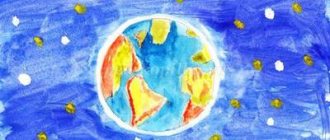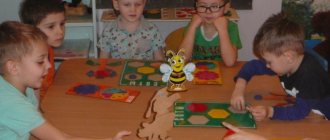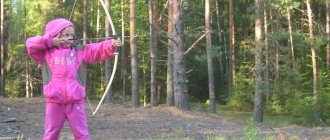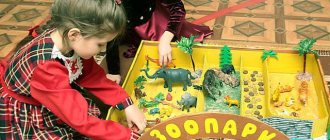Progress of the game
Educator: “ Snow , snow is spinning , the whole street is white!” The children are spinning.
Educator: “We all gathered in a circle and started spinning like a snowball.”
Children approach the teacher.
Educator: “Snowflakes and white fluffs have gone to bed”
. Children squat
Educator: “A cold wind blew, snowflakes scattered.”
Children run around the playground
5. Labor activity. Construction of buildings from snow
Goal: to teach how to shovel snow using shovels to a certain place, to instill hard work
The teacher invites those who wish to clear the area in front of the gazebo from freshly fallen snow . Children choose their own shovels and, together with adults, remove the snow (the teacher shows the actions)
. Then, if desired, you can sweep the area.
6. Independent activity
Having finished clearing the playground, children and their teacher can decorate it by placing colorful flags along the snow bank. The teacher praises them and thanks them for their diligence.
Some children play, others watch the actions of their comrades. The teacher can turn to a subgroup of 3-5 children and , holding out his hand towards the falling snow , ask them to guess: “White, fluffy, fell on his hand and disappeared. What it is? Did you guess right?
Progress of observation
The teacher asks the children a riddle.
Not washed, but shiny,
Not toasted, but crunchy. (Snow.)
The calmer the frosty weather, the more beautiful the snowflakes falling on the ground. In a strong wind, their rays and edges break off, and white flowers and stars turn into snow dust. And when the frost is not severe, snowflakes roll into dense white balls, and then we say that cereals are falling from the sky. Falling to the ground, snowflakes stick to each other and, if there is no severe frost, form flakes.
Layer after layer falls on the ground, and each layer is loose at first, because there is a lot of air between the snowflakes.
And the snow crunches because the stars and rays break under the weight of our body.
The teacher asks the children questions.
• In what weather do snowflakes form snow dust, grains, flakes?
Winter walk in the senior group. Abstract
Summary of a winter walk in the senior group of a kindergarten on the topic “Observing snowfall”
Author: Marina Viktorovna Vitskova, teacher of the MBDOU “Kindergarten “Goldfish” of the Astrakhan region, Chernoyarsk district. Description: using this material, children develop observation, curiosity, and attention. This material will be useful for parents and kindergarten teachers when conducting winter walks for older children. Goals: Continue to introduce natural phenomena; to develop cognitive interest and the ability to observe the world around them. Types of activities: gaming, cognitive-research, communication, basic household work. Materials : shovels, buckets, toys for children.
Progress of the walk
Watching snowfall.
Educator. Guys, look and tell me how it snows? Children. Snow falls to the ground quietly, snow falls in different directions. Educator. Snow is falling - this phenomenon is called snowfall (snow falls in flakes, snowflakes slowly fall on trees, on the roofs of houses, on the ground). Look how big the snowdrifts are on our site. Let's do an experiment with you. Why is the snow light? Children. The snow is soft, white, fluffy.
Conducting the experiment: “Why is the snow light?”
Goal: Improve children's knowledge about snow. Educator. Guys, let's shovel the snow into a pile with buckets. Now tell me, which snow buckets are light or heavy? Children. Snow buckets are lightweight. Educator. Remember, your children used to carry buckets of sand in the summer. Which sand bucket was light or heavy? Children. Sand buckets are heavy. So what about snow? Children. Snow is lighter than sand. Educator. What else could be heavier than snow? Children. Earth, water Educator. That's right, well done. Educator. Children, tell me what signs about snow do you know? Children. There will be a lot of snow - there will be a lot of bread. When the snow falls tightly to the fences - a bad summer. Snow sticks to the trees - it will be warm. The sun sets in the clouds - it will snow. It dawns quickly - it will snow. Clouds go against the wind - to the snow. Educator. What proverbs and sayings about snow do you know? Children. More snow in the fields means more bread in the bins. If a snowflake blows up, there will be more bread; if water spills, there will be hay. No matter how you wash, you will not be whiter than snow. Speeches are like snowflakes, but deeds are like soot. It’s not the snow that’s blowing, but the snow that’s coming from above. The first snowflake falls forty days before winter. Where there is snow, there is a trace: there was no snow, there was no trace. Educator. Well done boys.
Now tell me poems about snow. Children recite poems.
Here winter played snowballs, threw up a lot of snow, There is no way at all now, You can’t get through, you can’t get through!
In a snowy downy bed Pines are drowning, spruce trees are drowning... Everyone in the snow has become warmer, Snow is like a blanket for everyone! The first snow covered the ponds with ice. And the last rowan tree is pecked by blackbirds in reserve. Ice is transparent, fragile, thin - Don't go on the ice, child! White, delicate fluffy snow is spinning, falling, flying! White, sparkling pure, Lies on the ground, sparkling! Gently covers the earth, flutters in the air in a whirlwind! Dresses everything up with itself, amazes with beauty! The snow casts a spell, it snows, the snow blows snow... It swirls in the air, does not melt, It turns silver and sparkles... He wants to create magic, He will prophesy a fairy tale for us... The snow swirls, the snow swirls And lies on the fields All the roads are swept away This snowy winter The kids really like it Play sometimes have a snowball fight Ride on a sled Straight from the icy hill, Take skates or skis with you And rush to the skating rink, or to the forest! Educator. Guys, guess the riddle.
Mystery.
All day long, he flew, turning white, to the boulevards and alleys, lay down in the snowdrifts for the night... You guessed it!
This…. Children. Snow
Individual work.
Exercise children in throwing snowballs at a distance with their left and right hands.
Labor activity. “Remove snow from the paths” Goal: to involve children in performing simple tasks.
Game activity.
An outdoor game is being played: “Hunter and Hares” Purpose: to learn to throw a ball at a moving target. Progress of the game: On one side there is a “hunter”, on the other there are 2-3 “hares” in drawn circles. The “hunter” walks around the area, as if looking for traces of “hares,” then returns to his place. The teacher says: “The hares ran out into the clearing.” "Hares" jump on two legs, moving forward. At the word “hunter”, the “hares” stop, turn their backs to him, and he, without leaving his place, throws the ball at them. The “hare” that the “hunter” hit is considered shot, and the “hunter” takes it to himself. Educator. Children, did you enjoy the walk? What did we learn about snow today? What did you like most? Children talk about what they did, what they learned new, what they would like to learn more.
We recommend watching:
Summary of a lesson on the surrounding world for the senior group “Hello, Zimushka-Winter!” Summary of a lesson for older preschoolers “Hello, winter - winter” Summary of GCD in the senior group: How animals prepare for winter Summary of GCD on cognitive development in the senior group on the topic: Winter
Similar articles:
Walk “Wind Watching” in the senior group
Summary of the lesson “Birds in winter.” Senior group
Summary of a lesson on ecology in the senior group in kindergarten. Birds in the forest
Summary of a music lesson in kindergarten in the senior group on the topic: Winter
Entertainment “Visiting Winter” in kindergarten in the senior group
Summary of the walk in the senior group “Observation of snow and ice”
Svetlana Aleksandrovna Mazhova
Summary of a walk in the senior group “Observation of snow and ice”
• introduce children to a seasonal phenomenon - snowfall ;
• fix the names and sequence of the winter months
• form an idea of the diversity of water conditions;
• learn to shovel snow using shovels to a certain place;
• develop children's speech;
• enrich vocabulary ( snowfall , snowflake, blizzard, blizzard)
• develop motor activity;
spatulas, scoops, whisks, two glasses (for experimenting)
Content of direct educational activities
1. Organizational moment
Oh, you winter beauty!
Mountains of snow swept up ,
She invited us to go for a ride.
Guys, look, it's snowing . a lot of snow all around . Look, snow on the path, on the bench, and on the table. And he keeps falling and falling. It's snowing !
1. Tell me, what are the winter months called?
2. What winter sports do you know?
3. What do you like about winter?
Guys, let's do an experiment! snow in the other .
— What color is the ice? Name its properties. (cold, hard, transparent, brittle)
- What color is the snow ? Name its properties (cold, white, fluffy, soft)
- How are they similar? (this is frozen water, it only happens in winter, it’s cold)
- How are snow and ice different ?
Guys, after the walk , let’s put both glasses in a warm place, after a while we’ll see what happened to the ice and snow (under the influence of heat, snow and ice turned into water. This means that snow and ice are formed from water under the influence of frost)
-Now, guys, let's take a rest.
4. Physical education minute. Outdoor game " Snow is spinning "
Goal: to learn to correlate your own actions with the actions of the participants in the game; develop auditory attention, motor activity, and cultivate a desire to play outdoor games.






